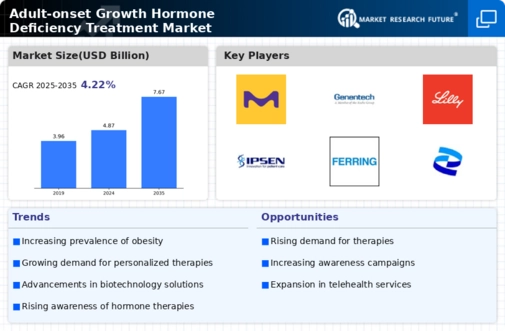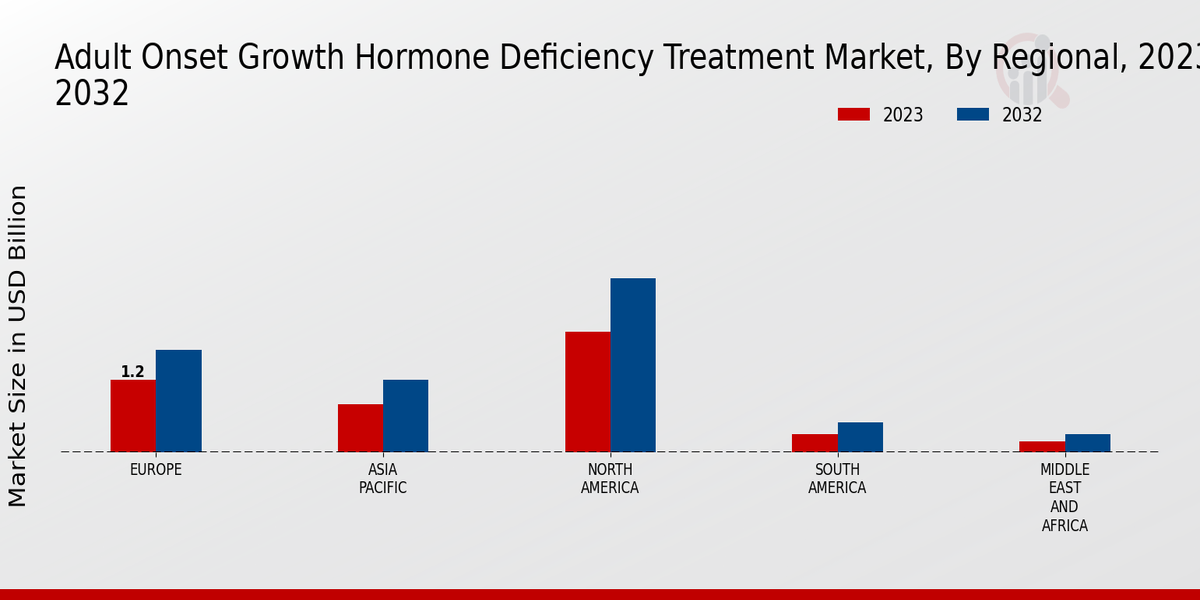Market Growth Projections
The Global Adult-onset Growth Hormone Deficiency Treatment Market Industry is projected to experience significant growth over the coming years. With a market value of 4.87 USD Billion in 2024, it is expected to reach 7.67 USD Billion by 2035, reflecting a compound annual growth rate (CAGR) of 4.22% from 2025 to 2035. This growth trajectory indicates a robust demand for growth hormone therapies, driven by factors such as increasing awareness, advancements in treatment modalities, and the rising prevalence of obesity. The market's expansion is likely to attract new players and foster innovation within the industry.
Advancements in Treatment Modalities
Innovations in treatment modalities are playing a pivotal role in shaping the Global Adult-onset Growth Hormone Deficiency Treatment Market Industry. Recent developments in recombinant DNA technology have led to the creation of more effective and safer growth hormone therapies. These advancements not only enhance patient outcomes but also improve adherence to treatment regimens. As a result, the market is expected to witness a compound annual growth rate (CAGR) of 4.22% from 2025 to 2035. The introduction of new formulations and delivery methods may further stimulate market growth, as patients increasingly prefer convenient and less invasive treatment options.
Regulatory Support and Approval for Treatments
Regulatory support for the approval of growth hormone therapies is enhancing the landscape of the Global Adult-onset Growth Hormone Deficiency Treatment Market Industry. Government agencies are increasingly recognizing the importance of these treatments for improving patient outcomes. Streamlined approval processes and favorable reimbursement policies are likely to encourage pharmaceutical companies to invest in research and development. This supportive regulatory environment may lead to a broader range of treatment options becoming available to patients, thereby expanding the market. As a result, the industry is poised for growth as new therapies enter the market.
Aging Population and Associated Health Challenges
The aging population worldwide is a significant driver of the Global Adult-onset Growth Hormone Deficiency Treatment Market Industry. As individuals age, the natural decline in growth hormone levels can lead to various health challenges, including decreased muscle mass and increased fat accumulation. This demographic shift is expected to increase the demand for growth hormone treatments, as older adults seek to maintain their health and quality of life. With the market anticipated to grow substantially, healthcare systems may need to adapt to accommodate the needs of this aging population, further propelling the industry forward.
Increasing Awareness of Growth Hormone Deficiency
The Global Adult-onset Growth Hormone Deficiency Treatment Market Industry is experiencing a surge in awareness regarding growth hormone deficiency among adults. Educational campaigns and initiatives by healthcare organizations are informing the public about the symptoms and potential treatments. This heightened awareness is likely to lead to increased diagnosis rates, thereby expanding the patient pool. As more individuals seek treatment, the market is projected to grow, with estimates suggesting a market value of 4.87 USD Billion in 2024. This trend indicates a shift towards proactive health management, which could further drive the demand for growth hormone therapies.
Rising Prevalence of Obesity and Related Disorders
The increasing prevalence of obesity and related metabolic disorders is contributing to the growth of the Global Adult-onset Growth Hormone Deficiency Treatment Market Industry. Obesity is known to be associated with hormonal imbalances, including growth hormone deficiency, which can exacerbate health issues. As the global population grapples with rising obesity rates, the demand for effective treatments is likely to escalate. This trend is underscored by projections indicating that the market could reach 7.67 USD Billion by 2035. Consequently, addressing obesity through growth hormone therapies may become a focal point for healthcare providers and policymakers.






















Leave a Comment